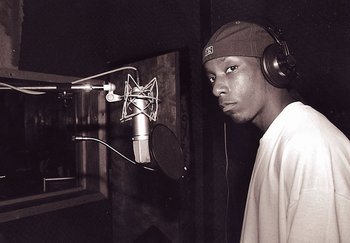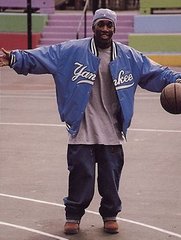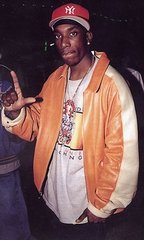 BigL
BigL
Raised in the Uptown sector's "Danger Zone"—139th Street and Lennox Avenue—young Lamont Coleman was referred to throughout his neighborhood as "Little" Lamont. As a youth, he was often faced with the temptations of the street life that surrounded him. Fortunately, hip-hop's burgeoning musical and cultural movement left its
indelible stamp on Lamont's conscience.Discovering that he himself possessed an affinity for rap's gift-of-gab, Coleman began to formulate a rhyme scheme. He decided that it was time to ditch the "Little," lose the Lamont and re-introduce himself to the rap world under a moniker that reflected the extra large talent brewing within his slight frame—Big L. After spending just a single year working on his wordplay, L heard from the grapevine that Lord Finesse was holding court in the back of a 125th Street record store and rushed right over to display his sharpened skills. A hot second later, Finesse wound up giving L his first crack on wax with 1992's much-revered "Yes You May (Remix)." "I only roll with originators/Chicks stick to my dick like magnets on refrigerators," L rhymed on his debut, displaying the unmistakably concise delivery and explicit but clever lyrical volleys that would characterize his work and rock-shock rap audiences for the next few years. In no time at all, L secured himself a deal with Columbia records, and in 1993 released one of the illest records of all time: the vinyl, promo-only "Devil's Son." Promising to "catch more bodies than abortion clinics," the murderous masterpiece became an immediate underground sensation well before the subsequent "horrorcore" style came into hip-hop vogue. L also proved himself ahead of the rap curve with the company he was keeping: his Uptown crew 8 Iz Enuff, which included such future Harlem World icons as Cam'Ron, McGruff, and a not-so-jiggy-back-then Ma$e. In addition to debuting this clique on his first solo album, 1995's Lifestylz of Da Poor & Dangerous, L also found time to give light to a then-emerging Brooklyn rhyme colleague named Jay-Z on the posse-banger "Da Graveyard." The Source magazine dubbed Lifestylez of Da Poor & Dangerous, "pure nineties B-boy them music" and gave it four mics in their March 1995 issue. Despite such early innovations, Big L's finest work still lay ahead of him. Appearances on two excellent indie singles with his D.I.T.C. cohorts, "Day One" and "The Enemy," set the stage. However, "Ebonics," a brilliant breakdown of street slang recited in inimitable Big L style, was his crowning achievement. Independently released on L's own Flamboyant imprint through Fat Beats and available only on vinyl, the single garnered critical acclaim and was picked as one of the top five "independent records of the year" by The Source magazine. "Ebonics" dissected the "criminal slang" of New York's underworld with unprecedented precision and clarity, and proved that he could bring the hardest of the hardcore together with a radio sensibility that made him unparalleled in the music business. Tragically, he would only too-briefly enjoy the success he so deserved. On February 15, 1999, Big L died of gunshot wounds sustained in a dispute that took place on the very 139th Street and Lenox Avenue block he once proudly called home. Though the hip-hop community lost one of its most promising voices that fateful day, the impact of Big L's music continues to resonate. Now, five years after his debut album, Big L's posthumous sophomore release titled The Big Picture is set to hit the streets on the Rawkus Records label. The album features production by DJ premier, Roc Raida, Lord Finesse, Buckwild, Show, Ghetto Professionals, Pete Rock and more. It also features guest performances by Sadat X, Guru, Kook G. Rap, Fat Joe and other members of the D.I.T.C. crew. While other rap recording artists may have reached higher plateaus of mainstream recognition, Big L was undoubtedly the nastiest and most exhilarating emcee to ever rock the mic. His movements in underground hip-hop have shifted the grounds of commercial sound and continue to mold up-and-coming acts. BIG L REST IN PEACE!
|
 Big L
Big L
. L also proved himself ahead of the rap curve with the company he was keeping: his Uptown crew 8 Iz Enuff, which included such future Harlem World icons as Cam'Ron, McGruff, and a not-so-jiggy-back-then Ma$e. In addition to debuting this clique on his first solo album, 1995's Lifestylz of Da Poor & Dangerous, L also found time to give light to a then-emerging Brooklyn rhyme colleague named Jay-Z on the posse-banger "Da Graveyard." The Source magazine dubbed Lifestylez of Da Poor & Dangerous, "pure nineties B-boy them music" and gave it four mics in their March 1995 issue. Despite such early innovations, Big L's finest work still lay ahead of him. Appearances on two excellent indie singles with his D.I.T.C. cohorts, "Day One" and "The Enemy," set the stage. However, "Ebonics," a brilliant breakdown of street slang recited in inimitable Big L style, was his crowning achievement. Independently released on L's own Flamboyant imprint through Fat Beats and available only on vinyl, the single garnered critical acclaim and was picked as one of the top five "independent records of the year" by The Source magazine. "Ebonics" dissected the "criminal slang" of New York's underworld with unprecedented precision and clarity, and proved that he could bring the hardest of the hardcore together with a radio sensibility that made him unparalleled in the music business. Tragically, he would only too-briefly enjoy the success he so deserved. On February 15, 1999, Big L died of gunshot wounds sustained in a dispute that took place on the very 139th Street and Lenox Avenue block he once proudly called home. Though the hip-hop community lost one of its most promising voices that fateful day, the impact of Big L's music continues to resonate. Now, five years after his debut album, Big L's posthumous sophomore release titled The Big Picture is set to hit the streets on the Rawkus Records label. The album features production by DJ premier, Roc Raida, Lord Finesse, Buckwild, Show, Ghetto Professionals, Pete Rock and more. It also features guest performances by Sadat X, Guru, Kook G. Rap, Fat Joe and other members of the D.I.T.C. crew. While other rap recording artists may have reached higher plateaus of mainstream recognition, Big L was undoubtedly the nastiest and most exhilarating emcee to ever rock the mic. His movements in underground hip-hop have shifted the grounds of commercial sound and continue to mold up-and-coming acts. BIG L REST IN PEACE!
|
 Big L
Big L
Though the hip-hop community lost one of its most promising voices that fateful day, the impact of Big L's music continues to resonate. Now, five years after his debut album, Big L's posthumous sophomore release titled The Big Picture is set to hit the streets on the Rawkus Records label. The album features production by DJ premier, Roc Raida, Lord Finesse, Buckwild, Show, Ghetto Professionals, Pete Rock and more. It also features guest performances by Sadat X, Guru, Kook G. Rap, Fat Joe and other members of the D.I.T.C. crew. While other rap recording artists may have reached higher plateaus of mainstream recognition, Big L was undoubtedly the nastiest and most exhilarating emcee to ever rock the mic. His movements in underground hip-hop have shifted the grounds of commercial sound and continue to mold up-and-coming acts. BIG L REST IN PEACE!

|